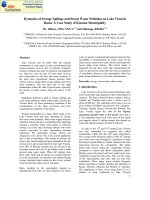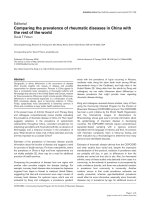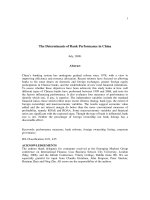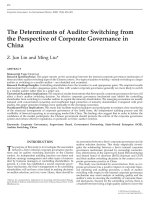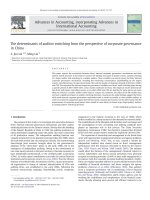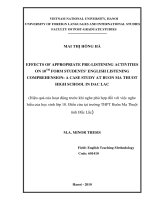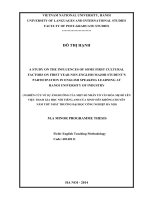Knowing the influences of context on electronic market adoption a case study of non acceptance of electronic market in large sized companies in china
Bạn đang xem bản rút gọn của tài liệu. Xem và tải ngay bản đầy đủ của tài liệu tại đây (537.15 KB, 103 trang )
THE SITUATED ORGANIZATION AND ELECTRONIC
MARKET ADOPTION
LI YAO
A THESIS SUBMITTED
FOR THE DEGREE OF MASTER OF SCIENCE (MANAGEMENT)
DEPARTMENT OF DECISION SCIENCE
NATIONAL UNIVERSITY OF SINGAPORE
Acknowledgements
First of all, I would like to sincerely express my gratitude to my supervisor,
Professor Hsiao Rueylin, for his stimulating suggestions and encouragement.
Without his guidance and support, the completion of this thesis would not have
been possible.
Thanks are also due to the examiners, whose suggestions and comments have
helped to further improve the quality of this thesis.
My appreciation also goes to the friends who acquainted me with
ChinaMarket, MobileCom, PCCom, PharmCom and EngCom, as well as those
who helped me with the fieldwork, and who have in one way or other helped me
in my pursuit of my Masters’ degree and the work on my thesis, particularly the
faculty members, staff and students at NUS business school.
Last but not least, I express my sincere gratitude to my beloved parents and
boy friend for their unfailing support and understanding.
i
Table of Contents
ACKNOWLEDGEMENTS .................................................................................. I
TABLE OF CONTENTS......................................................................................II
SUMMARY ......................................................................................................... IV
LIST OF TABLES............................................................................................... VI
LIST OF FIGURES ...........................................................................................VII
CHAPTER 1.INTRODUCTION .......................................................................1
CHAPTER 2.LITERATURE REVIEW ...........................................................4
2.1.
PREVIOUS LITERATURE ON THE FAILURE OF E-MARKET ADOPTION ............4
2. 1. 1. The “Conditions Thesis” ....................................................................5
2. 1. 2. The “Structure Thesis” .......................................................................7
2.2.
THE CONTEXTUAL ANALYSIS IN TECHNOLOGY ADOPTION .......................11
2. 2. 1. Research on the Contextual Analysis................................................ 11
2. 2. 2. Using the Contextual Analysis in Technology Adoption ...................12
2. 2. 3. The Contextual Analysis and E-market Adoption .............................13
CHAPTER 3.METHODOLOGY....................................................................19
3.1.
CASE BACKGROUND .................................................................................19
3.2.
DATA COLLECTION AND ANALYSIS ............................................................23
CHAPTER 4.FINDINGS .................................................................................29
4.1.
THE E-MARKET OF CHINAMARKET ..........................................................32
4.1.1.
Organizing Principles: Free Market Transactions ...........................32
4.1.2.
Core Practices in the E-Market ........................................................33
4.2.
CASE 1: ENGCOM .....................................................................................36
4.2.1.
Situated Contexts ..............................................................................36
4.2.1.1. The Industrial Context...................................................................36
4.2.1.2. The Supply Chain Context ............................................................38
4.2.2.
4.3.
The Contextual Re-situated Analysis ................................................41
CASE 2: MOBILECOM................................................................................47
4.3.1.
Situated Contexts ..............................................................................48
ii
4.3.1.1. The Industrial Context...................................................................48
4.3.1.2. The Supply Chain Context ............................................................51
4.3.2.
4.4.
The Contextual Re-Situated Analysis................................................56
CASE 3: PCCOM .......................................................................................59
4.4.1.
Situated Contexts ..............................................................................60
4.4.1.1. The Industrial Context...................................................................60
4.4.1.2. The Supply Chain Context ............................................................62
4.4.2.
The Contextual Re-situated Analysis ................................................66
CASE 4: PHARMCOM ...........................................................................................70
4.5.1.
Situated Contexts ..............................................................................71
4.5.1.1. The Industrial Context...................................................................71
4.5.1.2. The Supply Chain Context ............................................................73
4.5.2.
The Contextual Re-situated Analysis ................................................76
CHAPTER 5.IMPLICATIONS .......................................................................80
5.1.
IMPLICATIONS ...........................................................................................80
5.1.1.
Theoretical Implications ...................................................................80
5.1.2.
Practical Implications.......................................................................82
5.1.
LIMITATIONS AND FUTURE DIRECTIONS ....................................................87
CHAPTER 6.CONCLUSION..........................................................................90
BIBLIOGRAPHY ................................................................................................92
iii
Summary
The challenges for organizations intending to adopt the Business-to-Business
(B2B) electronic market are varied. In the face of these difficulties, this thesis
suggests an alternative approach for examining e-market adoption by focusing on
the features of the organization rather than the features of e-market technology.
This thesis indicates that one core institutional feature for an organization is that
the organization is always situated in its context. On this basis, this thesis points
out that e-market adoption is often accompanied by a series of changes in an
organization, and with these changes, it may not be necessarily able to re-situate
into its original context. If the organization encounters contextual re-situated
difficulties, it will not only fail to benefit from e-market adoption, but its normal
operation may also be disrupted by the adoption of the e-market. Hence, an
organization which expects that it will suffer contextual re-situated difficulties due
to e-market adoption is unlikely to adopt the e-market unless it figures out a
method to resolve these difficulties.
In order to understand the importance of contextual re-situation in e-market
adoption, this thesis has analyzed the contextual re-situated issues in four case
companies, including one successful adopter, and other three companies that
rejected the e-market. Through discussing the (possible) changes resulting from
e-market adoption, and the impact of these changes on contextual re-situation, this
thesis concludes that one reason for companies opting not to adopt the e-market is
the irreconcilable conflicts between the changed organization and its original
supply chain and industrial contexts.
This thesis contributes to current e-market adoption literature by highlighting
the necessity for organizations to achieve contextual re-situation with the
iv
influence of e-market adoption. From a practical viewpoint, the thesis also
addresses how companies may take advantage of the e-market within their
difficult industrial and supply chain contexts.
v
List of Tables
Table 1. The Comparison of the “Conditions Thesis”, the “Structure Thesis”
and the Contextual Analysis........................................................................15
Table 2. Data Collection.......................................................................................26
Table 3. Sets of key points summarized from multiple data sources for the
PCCom case..................................................................................................28
Table 4. The Re-situated Analysis for Four Case Companies ..........................30
Table 5. The Information Flow and Buyer-Supplier Relationship in An
E-Catalogue, An E-Procurement and An E-Auction ................................35
Table 6. The Duration of the Price Negotiation for Various PC Components66
Table 7. The Suggested Solutions for Common Challenges .............................85
vi
List of Figures
Figure 1. The Conceptual Frameworks of the “Structural Thesis” and the
Contextual Analysis Used in This Study ....................................................16
Figure 2.
The Components and Operating Principle for Telecom
Infrastructures .............................................................................................53
Figure 3. The Supply Chain Structure of PCCom ............................................64
vii
Chapter 1.Introduction
When marketing the electronic market (e-market) to organizations, providers
find that they are often confronted with differing attitudes of organizations
towards the e-market. These differences can be viewed from two opposing
viewpoints. First, organizations assess e-market products differently from
providers. Providers intend to emphasize a product’s technological features, such
as advanced functions and the high integration capability of e-market systems.
However, organizations are more concerned about whether an e-market product
could add value to their business. Second, the emphasis of providers on e-market
usage is again different from that of organizations. Providers designing a product
aim to meet the general needs for most organizations. However, the prime concern
of most organizations is whether the technology product suits their own business
requirements. Such conflicts of interest between providers and recipient
organizations lead to various problems in e-market adoption, and these problems
in turn motivate researchers to ponder the possible causes of such problems from
different perspectives, be they those of providers, organizations or both.
Most previous literature has analyzed problems in e-market adoption mainly
from the provider’s perspective. The researchers argue that adoption difficulties
are due to the lack of favorable conditions or of all the successful factors needed
to adopt the e-market (Chwelos et al., 2001; Farhoomand et al., 2000; Kumar &
Crook, 1999; Markus & Soh, 2002). More recent studies have started taking into
account the viewpoints of providers as well as those of organizations. They
suggest a better understanding of adoption problems can be achieved by analyzing
fundamental misalignments between an e-market product and the recipient
organization (Clemons & Row, 1993; Kambil & van Heck, 1998; Levecq and
1
Weber, 2002). The fundamental misalignment is defined as “differences between
the structures embedded in the organization (as reflected by its procedures, rules
and norms) and those embedded in the package 1 ” (p376, Soh & Sia, 2004). This
stream of research has drawn attention to the viewpoints of organizations and
provided a deeper insight into e-market adoption. However, I believe that these
efforts are still inadequate as few of them have explored the problems in e-market
adoption from the viewpoint of recipient organizations. To that end, this study
attempts to address this deficiency in order to gain a better understanding of the
problems of e-market adoption.
The theoretical perspectives that I found most helpful in examining difficulties
in e-market adoption from the recipient organization’s perspective are in the field
of organizational change. In particular, the contextual perspective of
organizational
change
(Pettigrew,
1990)
has
provided
a
method
for
conceptualizing the relationship between organizations, organizational changes
and e-market adoption. According to the contextual perspective, an organization
is formed and changed in a specific context. The adoption of technologies, like the
e-market, would be treated as a trigger of change for this organization (Avgerou,
2001; Avgerou et al., 2004; Walsham & Waema, 1994; Walsham & Sahay,
1999).Once it has adopted the e-market, the organization may face some new
changes that make it hard for it to fit into its original context, and these potential
new changes may in turn lead to difficulty for this organization in adopting the
e-market. In the light of this contextual perspective, research questions addressed
in this research are:
1. What is the original context of an organization? In such a specific context,
1
Package in this context refers to technology products, which include hardware,
software and data structure, and so on.
2
how does an organization operate (its practices)?
2. What might be the impact on the organization’s practices when the
e-market is adopted?
3. How may the fitness of an organization in its original context be impacted
by the changes in its practices?
Some key terms used in research questions are defined here. The term
“organizations” in this study refers to adopters or potential adopters of the
e-market. An organization’s “practices” in the context of this study are defined as
the organization’s supply chain practices. Correspondingly, an organization’s
“context” is the industrial context in which the organization’s supply chain
practices are formed and changed.
In Chapter 2, literature on e-market adoption and the contextual analysis is
reviewed. Chapter 3 describes the background information of this research, and
elaborates on the methods used in collecting and analyzing data. Chapter 4 first
examines the context and contextual re-situated issues for a successful case
company in e-market adoption, then the context as well as the contextual
re-situated analysis of three case companies in China are conducted. In Chapter 5,
both the theoretical and practical implications of this research are discussed. The
limitations and future directions are also highlighted in this chapter. Chapter 6
draws conclusions based on the findings of this study.
3
Chapter 2.Literature Review
This chapter begins with a review of previous literature on e-market adoption.
This is followed by a discussion on present studies which apply the contextualist
perspective in analyzing technology adoption, as well as on the conceptual
framework of this study.
2.1. Previous Literature on the Failure of E-market Adoption
The key terms used in the research on the failure of e-market adoption are
defined first, in order to focus on the insights provided by literature in this field.
These terms include the “e-market” and “adoption failure”. The e-market is a
virtual platform on the Internet, which brings various sellers and buyers together
to share information and conduct transactions. In this study, the e-market mainly
refers to a system that can support online transactions. Most e-market systems
often contain three technological elements: e-catalogue (electronic catalogue),
e-procurement (electronic procurement) and e-auction (electronic auction). One
example of such an e-market provider is Ariba (www.ariba.com).
Adoption failure is often perceived from three perspectives. From the first
perspective, non-acceptance of the e-market is considered as adoption failure.
There is a suggestion from the second perspective that adoption failure should be
measured by the frequency and/or extent of usage of the e-market in an
organization. It argues that an organization which adopts the e-market in name
may not use the e-market extensively. In this case, such an organization cannot be
considered as a successful adopter. The third perspective further indicates that the
extensive usage of the e-market in an organization is not without its problems. The
wide usage of the e-market may not ensure that the organization benefits largely
from e-market adoption. In fact, it might lead to malfunction of the organization
4
under some circumstances. Accordingly, the third perspective suggests that
adoption failure is measured by assessing the benefits the organization gains from
e-market adoption.
In the following sections, two major strands of research that analyze the
failure of e-market adoption are discussed separately. The first strand has mainly
conducted analyses from the viewpoint of providers. It attributes the failure of
e-market adoption mainly to undeveloped conditions. Hence, this strand of
research is referred to as the “Conditions Thesis”. The other stream adopts the
viewpoints of both providers and organizations. It considers the structural
misalignment between the organization and the e-market as the main cause of
adoption failure. Thus, this stream of research is referred to as the “Structure
Thesis”.
2. 1. 1. The “Conditions Thesis”
The “Conditions Thesis” defines adoption failure as the non-acceptance of
e-market systems. It believes that such adoption failure is caused by the fact that
the conditions for e-market adoption in an organization are not adequately
developed (Iacovou et al., 1995; Xu et al., 2004; Zhu et al., 2006). Researchers
often assess conditions from three aspects: conditions of technology products,
conditions of organizations and conditions of the public infrastructure. The
conditions of technology products are concerned with the technological capability
of e-market systems, for example, the functional capability, ease of use, and the
integration capability of a certain system. The conditions of organizations include,
for example, the financial capability of organizations, the existing technological
conditions of organizations, and the technological skills of the organization’s
present employees. The conditions of the public infrastructure take into
5
consideration, for example, the legal infrastructure, the logistics infrastructure,
and the telecommunications infrastructure of an organization.
According to the “Conditions Thesis”, therefore, adoption failure would be
avoided if conditions for e-market adoptions were adequately developed. To
provide the adequately developed conditions, two approaches are suggested: 1)
improving current conditions through barrier removal; or 2) conditions to improve
over time. For instance, the study of Farhoomand, Tuunainen and Yee (2000)
examined 10 companies in Hong Kong and Finland to identify key barriers
hindering or slowing down the wide acceptance of global electronic commerce.
Based on the classification of electronic commerce issues, the findings of the
above study show six key barriers, which are mainly related to technical,
organizational, economic, political, cultural and legal issues. They suggested that
these adoption barriers could be removed as electronic commerce technologies
became more mature. As a result, electronic commerce could be successfully
adopted by more companies.
The “Conditions Thesis” offers an approach for examining the problems of
adoption failure, and accordingly proposes possible solutions based on the
conditional analysis as well. However, the successful adoption of e-market
systems like Alibaba, even in unfavorable conditions has enabled researchers to
notice the deficiencies of the “Conditions Thesis” (McFarlan and Young, 2001).
Researchers have begun realizing that although favorable conditions greatly
increase the possibility for organizations to accept the e-market successfully, they
are not absolute conditions for successful adoption. Hence, another stream of
research on the failure of e-market adoption, known as the “Structure Thesis” has
emerged. These studies do not treat the e-market system as a black box, but
6
instead examine structures embedded in e-market systems.
2. 1. 2. The “Structure Thesis”
The “Structure Thesis” differs from the “Conditions Thesis” in several aspects.
First, unlike the “Conditions Thesis”, the “Structure Thesis” stresses that adoption
failure should instead be measured by the usage of the e-market in an organization.
It argues that if an organization does not use a system extensively, it is very likely
for this organization to abandon the system subsequently.
Second, the causes of adoption failure assumed by these two “theses” differ.
The “Conditions Thesis” assumes that the e-market system is a black box, and
attributes adoption failure to immature conditions. However, the “Structure
Thesis” examines structures which are embedded in the systems. It suggests that
adoption failure is caused by underlying misalignments between structures
embedded in systems and in the recipient organizations. According to Levecq and
Weber (2002), the market microstructures, such as market mechanism, price
discovery rules and transparency, were embedded in the e-market when the
systems were being developed. When the e-market is adopted, companies are in
fact transferring the institutional structures embedded in the e-market into the
organization. However, the institutional characteristics of e-market technology
may not necessarily be aligned with those of the recipient organization. In such a
case, the technology might disrupt the existing organizing principles. For instance,
the e-market may disrupt the pre-existing market-making mechanism,
coordination methods, trust production, as well as buyer-supplier relationships in
the supply chain (e.g. Clemons and Row, 1993; Kambil and van Heck, 1998;
Pavlou and Gefen, 2005).
Kambil and van Heck (1998), for example, discussed four e-market adoptions
7
in the Dutch Flower Auction markets. The Dutch Flower Auction markets are the
world’s leading centres for trading cut flowers and potted plants. There are
thousands of sellers (flower growers) and buyers in the market, and the price in
the market is determined by the “Dutch Auction” method. In the early 1990s, in
order to face new challenges in the market, some Dutch Flower Auction markets
sought to transform their trading mechanism by adopting the e-market, including
the four adoption cases in the Kambile and van Heck (1998) study. However,
although the adoption conditions were almost similar, the outcomes of these four
e-market adoptions were different. There were two successes and two failures.
To understand this phenomenon, the researchers focused on changes in trading
processes that were enabled by e-market adoption in the Dutch Flower Auction
markets. The findings show that the adoption of the e-market called for the
introduction of a new trading mechanism for the Dutch Flower Action Markets. If
a flower market could, with the stimulus of the e-market, reengineer its prevalent
trading processes, and thus shape a process that could benefit most shareholders,
these changes in trading processes would be accepted by shareholders, and the
e-market adoption would succeed. Otherwise, neither reengineered trading
processes nor the e-market could be accepted. In this case, technology could
disrupt the trading mechanisms embedded in the e-market and cause failure.
According to the assumptions of the “Structure Thesis”, the key to avoiding
adoption failure is to achieve structural alignment between e-market systems and
recipient organizations. Three methods are often suggested. The first method is to
customize the e-market in terms of the structures of recipient organizations. This
method is a possible choice for achieving structural alignments, but organizations
often do not employ this approach for two reasons. First, e-market systems are
8
designed by providers (e.g. Ariba and CommerceOne) according to the general
needs of organizations. Thus, it is difficult to ask providers to redesign their
systems to cater to the needs of a specific organization. Second, organizations
adopting an e-market often aim to transform their current practices. Customizing
applications according to the structures of companies is like putting the cart before
the horse.
The second method is to reengineer the processes of companies based on the
structures embedded in e-market systems. Researchers who support this method
argue that structures embedded in systems reflect the “best practices” on
procurements for organizations, and that organizations attempt to transform their
practices into best practices through adoption of the e-market. For instance, Lee
and Clark (1997) analyzed four cases of e-market adoption. Of these, two were
successful, while two failed. They examined the economic benefits in each case
by investigating how the innovations enabled by information technology reduced
transaction costs and increased market efficiency. They concluded that companies
aiming to redesign market processes using e-market solutions, should plan
carefully to ensure that the benefits of the proposed new market processes were
not disrupted by the existing structures of the companies.
The third method is to align the structures embedded in the e-market with
those of companies. This approach suggests that providers use differentiation
strategies to attain alignments. Soh, Markus and Goh (2006), for example, pointed
out that suppliers would resist adopting e-market because of their concern that the
great transparency caused by adopting the e-market would lower their bargaining
power in transactions. After examining 19 e-market providers, they suggested that
providers which adopt the differentiation strategy are more likely to provide
9
compensatory benefits in the form of greater price transparency for sellers and in
the form of lower price transparency for buyers, in order to achieve success in the
e-market.
Studies on the “Structure Thesis” offer a deeper insight into adoption failure,
as they take into account structures embedded in e-market systems. However, the
“Structure Thesis” does not explain why an e-market system that is successfully
adopted in one industrial context fails to be accepted in another industrial context,
whose structure is nearly the same as that of the first. Avgerou (2001) discussed
such a case in her study. The small and medium-sized enterprises (SMEs) of the
textile industry in Emilia-Romagna in Italy successfully adopted flexible
specialization through e-market adoption. The SMEs of the furniture industry in
Cyprus have similar market structures to those of the SMEs of the textile industry
in Emilia-Romagna. When the SMEs in the furniture industry attempted to adopt
flexible specialization, they learnt from the textile industry’s experiences and used
an e-market system similar to the SMEs in Emilia-Romagna. Nevertheless, in the
Cyprus’s case, e-market adoption failed and Cyprus’s SMEs did not achieve the
projected success of their counterparts in Emilia-Romagna. Avergou (2001)
argued that examining the structures embedded in e-market systems was not
sufficient for understanding the institutional features of e-market adoption. In fact,
researchers also need to draw their attention to the context, which forms the
structure, and could change the structures over time. In the next section, the
contextual analysis is first introduced. Then, it is followed by a discussion on the
application of the contextual analysis in studies on technology adoption and
e-market adoption.
10
2.2. The Contextual Analysis in Technology Adoption
This section first introduces the contextual analysis in literature on change
management and technology adoption. It is followed by a detailed elaboration on
the application of the contextual analysis in e-market adoption. The similarities
and differences between the contextual analysis, the “Conditions Thesis” and the
“Structure Thesis” are also compared in this section.
2. 2. 1. Research on the Contextual Analysis
In 1985, based on the contextualism proposed by Stephen Pepper (1942),
Pettigrew developed a theory on contextualist research to analyze change
management. Pettigrew (1990: 270) also defined context in his study thus:
“Context is not just a stimulus environment, but a nested arrangement of
structures and processes where the subjective interpretations of actors perceiving,
comprehending, learning and remembering help shape process.”
This statement indicates two key points in the contextual analysis. First, it
emphasizes that organizations are situated in specific contexts over time. The
context is more than a circumstance for organizations; it is also a structure which
can interact with structures of organizations. This definition of context explains
the reason why organizations can be formed, and also changed in context. Second,
an actor’s practices play a pivotal role in the contextual analysis, as it can reflect
processes of organizational changes that happen in context. An artifact is viewed
as the object that could trigger organizational change. However, an artifact does
not change an organization directly. Instead, it does so through an actor’s practices.
Actors in an organization interpret the artifact in their practices; while these
interpretations also impact their practices and reflect changes in their practices. On
the other hand, an actor’s practices represent structures of organizations, which
11
could influence the structures of the contexts. Thus, when any changes occur in an
actor’s practices, these changes would result in some adjustments between the
structures of an organization and those of its context. If these adjustments are
acceptable, the organization will experience organizational change without
interrupting the organizational context. Otherwise, the changes introduced by an
artifact will be strongly resisted by the organization at the beginning, or lead to the
failure of organizational changes.
2. 2. 2. Using the Contextual Analysis in Technology Adoption
Technology adoption often results in organizational changes. Hence, the
contextual analysis has been used by researchers in the field of technology
adoption, such as the study of Avgerou, Ciborra and Frank (2004). These studies
adopting the contextual analysis have made several contributions to technology
adoption. First, they redefine the concept of the technology. They treat the
technology as an artifact for organizational changes, which can be perceived from
two perspectives. One refers to the technology as a physical technology product,
for example, software, hardware, data and electronic tables. The other refers to the
technology as the interpretations of actors (e.g. product designers and users) in
their practices. The second perspective indicates that the contextual analysis in
technology adoption draws more attention to structures embedded in technology
products.
Second, researchers emphasize the importance of practices in the application
of the contextual analysis on technology adoption. For instance, Walsham and
Sahay (1999) indicated that when using the contextualism perspective as an
analytical tool, one must examine “in detail the actions, the perceptions of human
actors and the context within which these actions took place and perceptions were
12
formed” (See p41). The reason is that in practice, designers and users create
different interpretations of the technology within the influence of the context
(Orlikowski, 2000). These interpretations influence structures of the organization,
and in turn cause organizational changes. If the changed structures of the
organization can continue to conform to the organization’s original context, the
organizational change would be accepted, and the technology adoption would
succeed. Otherwise, neither organizational changes nor the technology will be
accepted by the organization ultimately.
Finally, the multi-level features of context are also highlighted in using the
contextual lens to analyze technology adoption. As Avgerou (2001) noted, the
focus of studies on technology adoption has extended beyond the local context of
the organization, and includes aspects of the organization’s environment, such as
the national and international contexts. Researchers adopting such multi-level
analyses aim to grasp a better understanding of organizational changes through
examining context at different levels and the interdependent relationships between
contexts at the higher or lower levels.
2. 2. 3. The Contextual Analysis and E-market Adoption
. Some recent studies on e-market adoption have drawn attention to the
importance of context. For instance, Cousins and Robey (2005) have pointed out
that structures embedded in e-market systems are socially shaped by context.
Moreover, Avgerou (2001) suggests that “IS studies should go beyond the
technical/rational actions of professional experts and managers, and should
consider the institutional forces—both within an organization and its
environment—that necessitate or legitimate such actions”. The institutional forces
in this statement are indeed within the context of e-market adoption.
13
As in the previous two theses on e-market adoption, the contextual analysis
also defines adoption failure first (A detailed comparison of the “Conditions
Thesis”, the “Structure Thesis” and the contextual analysis is found in Table 1). In
the contextual analysis research, it is argued that as long as an organization cannot
receive projected benefits from e-market adoption, researchers will consider the
adoption as a failure. Researchers define adoption failure in this way, because they
observe an interesting phenomenon in some organizations. Even though
organizations may widely use the e-market system with external incentives or
forces, they could still abandon the system once these external incentives or forces
are withdrawn. For instance, many organizations are likely to abandon the
e-market when providers stop offering external incentives like free services. An
example of an external force is when the subsidiary company does not use the
e-market frequently owing to lack of supervision from its parent company.
Researchers indicate that these phenomena occur because organizations do not
gain real benefits from e-market adoption. As a result, they measure adoption
failure of the e-market in terms of the benefits gained in adoption.
14
Table 1. The Comparison of the “Conditions Thesis”, the “Structure Thesis” and the Contextual Analysis
Conditions Thesis
Structure Thesis
Contextual Analysis
The e-market system is a black box. There are structures embedded in the There are structures embedded in the e-market
Key
system.
e-market system.
Assumptions Adoption failure is caused by the fact
Adoption
failure is a result of the misfit of an
Adoption
failure
is
caused
by
that
conditions
of
e-market
of adoption
organization within its original context when
underlying misalignments between
adoption are under developed.
failure
the organization changes after adopting the
structures embedded in systems
e-market.
and those of recipient
organizations.
The features The key to avoiding adoption failure The key to avoiding adoption failure The key to avoiding adoption failure is to find a
way that can effectively assess the fitness of
is to achieve the structural
is to make conditions for e-market
of approaches
the changed organization within its original
alignment between e-market
adoption adequately developed.
context even before an organization adopts
systems and recipient
the e-market.
organizations.
Similarities:
Similarities
The “Structure Thesis” and the contextual analysis share the same viewpoint on e-market systems. They both do not treat the
and
system as a black box, and do examine structures embedded in the system.
Differences
Differences:
The viewpoint of the “Conditions Thesis” on the e-market system is different from that of the “Structure Thesis” and the
contextual analysis.
The objects examined in the “Structure Thesis” are different from those of the contextual analysis. The “Structure Thesis” only
examines organization structures and structures embedded in the system. However, the contextual analysis also introduces
the context in which the organization is situated.
The investigation of the relationship between the “Structure Thesis” and the contextual analysis is different. The “Structure
Thesis” focuses on the structural alignment between the organization and the system. However, the contextual analysis
focuses on the fitness of the organization within the context. The structure alignment is viewed as an important factor which
influences the fitness between the organization and its context.
Avgerou, 2001;
Kambil and van Heck, 1998;
Iacovou, Benbasat and Dexter,
Important
Barrett and Walsham, 1999;
Lee and Clark, 1997;
1995;
references
Kumar, van Dissel and Bielli, 1998.
Soh, Markus and Goh, 2006.
Xu, Zhu and Gibbs, 2004
Zhu, Kraemer and Xu, 2006
15
According to the contextual analysis, adoption failure is the result of the misfit of an
organization within its original context when the organization changes after adopting the
e-market. The key assumption of the contextual analysis is very similar to that of the
“Structure Thesis”, since both of them closely analyze e-market systems and examine the
impact of structures embedded in systems on e-market adoption.
Figure 1. The Conceptual Frameworks of the “Structural Thesis” and the Contextual
Analysis Used in This Study
Before
E-Market Adoption
After
The “Structure Thesis”
Organization
+
e-Market
=?
Organization
with e-Market
Contextual Analysis
Industrial Context
Industrial Context
Supply Chain
Context
Supply Chain
Context
Situated
Organization
?
Situated
Organization
with e-Market
Note:
1. The question mark in the “Structure Thesis” section represents the question: Can the organizational structure align with structures
embedded in electronic market systems?
2. The question mark in contextual analysis section represents the question: Can the organization with e-Market be re-situated in its
original context again?
However, the differences between the “Structure Thesis” and the contextual analysis
are also clear (See Figure 1). The key question of the “Structure Thesis” is whether
structural alignments between the organization and the e-market can be achieved. If
structural alignments cannot be attained, e-market adoption will fail. Accordingly, the
purpose of each approach suggested by the “Structure Thesis” is the same and often
involves aligning organizational structures with structures embedded in e-market systems.
16
With the contextual analysis, although it also draws attention to matters of structure, its
key question is different from that of the “Structure Thesis”. The contextual analysis on
e-market adoption is concerned with whether the organization with changes brought
about by e-market adoption can be situated in its original context again. If the
organization cannot be situated in its original context after adopting the e-market, the
adoption would have failed even though structural alignments were well achieved. Thus,
according to the contextual analysis, the solution to avoiding adoption failure is to find a
way to effectively assess the fitness of the changed organization within its original
context even before the organization adopts the e-market.
Current literature which applies the contextual analysis on e-market adoption mainly
employs two methods. The first method measures the organization’s contextual fitness at
the level of national culture. For instance, Kumar, van Dissel and Bielli (1998) discussed
an e-market system—Sprintel—experienced initial success and consequent failure when
it was adopted in Prato, Italy. They noted that the e-market brought impersonal trading
arrangements to the Pratesian textile merchants, who have traditionally valued
long-standing relationships. Such conflict of buyer-supplier relationships shaped in
different cultural contexts eventually led to the failure of Sprintel. Studies using this
method provide helpful insights into e-market adoption and are easily generalized, but the
problem is that the national culture context being considered on a macro-level is unlikely
to make much impact on e-market adoption. For instance, the success of TradeNet in
Singapore (Teo et al., 1997), and the successful deployment of the e-market of Li and
Fung in China (McFarlan and Young, 2000) are outstanding examples that the e-market
can still be successfully adopted in a cultural context outside the US.
The second method measures the contextual fitness at the level of organizational
17
